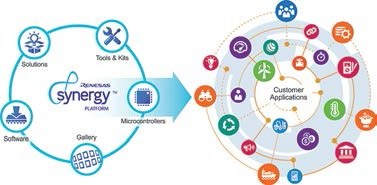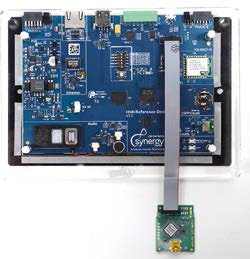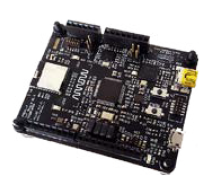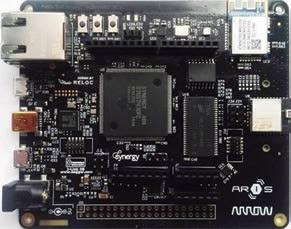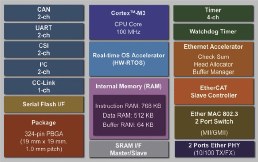Integrated hardware and software solutions, which reduce time spent on undifferentiated functions, freeing developers to focus on their application code.
A couple of years ago when Renesas engineers began to consider what an MCU-based solution package for the IoT market would look like, they took a close look at the unique challenges of this emerging emerging opportunity. With applications ranging from automated factory flooring to home automation applications and clothing measurements, the opportunities seem endless. Clearly those developers who are the first to deliver their products to the market will have a significant advantage. Thus, any solution that can shorten development time in the lab offers a powerful advantage. But Renesas's team observed something else. They explored this topic across industries and realized that it was changing the profile of their traditional MCU customer. As a leading MCU supplier for many years, Renesas engineers typically work with their customers' hardware engineers. Quite often, the customer's hardware team comes to Renesas looking to implement specific specifications. Once the Hardware is defined, the client's HW engineers pass the solution to their SW team to develop solutions. In most cases HW engineers handle the selection process for their MCUs. However, since the IoT market began to emerge, these roles are changing. The more Renesas interacts with its customers, the more evident it becomes that the dominant requirement in selecting an MCU is the Software component. Software developers now play a larger role in defining the final solution, and with it, what type of MCU will best fit your system requirements. So the Renesas team has grappled with how to handle this new reality. What are the key values that clients drive and how do these priorities impact the selection of the MCU? Clearly any solution targeting the huge IoT market has to take into account the growing importance of the software engineering point of view. What is the cause of the delays? According to a UMB survey, the problem is attributed to increasing complexity in the code, the integration of new technologies and more and more time spent with the software development tool and operating systems. In traditional development cycles, designers spend large chunks of time on hardware design, controller design, middleware development, RTOS integration, and connectivity options. Each of these SW development tasks spends most of the total project development time. However, all of the software design tasks mentioned above represent basic core system functions. Often at the end of the development cycle, when designers are typically under severe time constraints due to project delivery deadlines, clients are able to spend substantial amounts of time on what really sets their design apart - The code of application. For most cases, the result is to delay the release of your product or limit the features of your product. At the same time other trends are increasing the pressure on design teams. More and more electronics developers in the United States and Europe are outsourcing, but the foundation of the engineering functions necessary to differentiate their final products is their own. As engineering resources dwindle, it is finding that an increasing number of engineers are no longer able to develop new base technologies, or build new technology blocks, as they did in the past. As a result, developers are increasingly willing to move away from traditional in-house development of these core technologies and to increasingly use external resources and off-the-shelf components. However, it is a time consuming and expensive approach to use a standard MCU and then investigate the type of licensing, integration, testing and maintenance of the RTOS, Stacks, middleware and multi-vendor software libraries. What if you could get everything from the same source - your same silicon supplier? But to acquire software from their silicon vendor, developers need collateral. How long will the silicon vendor be able to supply and maintain the software? Will the vendor make a long-term commitment to maintain, update, and support the software? Developers generally equate commercial quality with longevity. If the silicon vendor is willing to sell their software as a high-quality commercial product, would this insure developers of embedded systems? From a developer's point of view, purchasing software components from an MCU vendor offers numerous advantages. Major Silicon providers generally have resources to support development and maintain software for long periods of time. And since silicon manufacturers generally have a large customer base, the software will be tested and demonstrated across a large number of customers. Furthermore, buying the silicon and software from the same company links the interests of the supplier and the seller. Since the silicon supplier only makes money when the products go into production, it has the same interest as the customer in speeding up the development cycle. Ultimately, the silicon manufacturer has a vested interest in maintaining software quality because the success of their software is directly tied to their ability to continue selling MCUs. The Renesas team wondered, what if designers could reinvent their time-consuming development cycle and focus on the truly innovative aspects of their solution? What if an MCU vendor like Renesas could reduce the amount of time designers spend developing these core features, and instead allow designers to increase the amount of time they can spend developing the game? your application code? What would this new product development cycle look like? In the traditional development cycle, designers must deal with continuous updates and constantly changing plans for their tools, stacks, and RTOS. What if the MCU vendor offers a synergistic platform that takes care of the integration of new versions, so that developers can reduce part of their development cycle and spend more time innovating? And what if the MCU vendor offers and maintains this software as a high quality commercial product and with APIs to allow the developer to simply build their own applications on top of that software foundation?
Elements of the Renesas Synergy Platform
The Renesas Synergy Platform consists of five main elements: Software, MCUs, Tools and Kits, Solutions, and the Gallery. The core element of the Renesas Synergy Platform is the embedded software that is qualified, verified and tested under commercial standards and ensures compatibility with Renesas Synergy MCUs, and all supported by Renesas. Renesas Synergy's qualified components are not only optimized and integrated into the MCUS, but are also rigorously tested to give maximum performance and reliability. Sold, maintained, and directly supported by Renesas as a product, these component qualifications undergo multiple levels of testing and are guaranteed by Renesas to perform as specified in the software datasheet. This skin is an industry first for the MCU. No other MCU manufacturer provides a Software datasheet with warranties. Software data sheets specify functions and features and also include parameterization data, in which the software is guaranteed to work. Some software components also undergo appropriate industry standard testing.
Renesas Synergy Software Suite
The core of the qualifying components come in a Renesas Synergy Software Package (SSP). Supplied with every Renesas Synergy MCU and included in the MCU price, the SSP provides the key software components necessary for all basic system functions essential for most embedded systems and IoT applications. Renesas engineers have selected a premium-quality operating system, Express Logic's ThreadX ® , as the foundation of the SSP, adding middleware components from Express Logic's X-Ware™, and integrated with Renesas MCU-specific software components that They include drivers, middleware, libraries, and a flexible application framework with an API. ThreadX® is a popular industry-proven, priority-based, deterministic multitasking operating system with a core system of preemptive services, round-robin scheduling, semaphores, message queues, timers, interrupts, and memory management with advanced features such as scheduling. preference-threshold to reduce context switches and run-time stack analysis and built-in programming event tracing capabilities. The ThreadX ® operating system has deployed to more than 2 billion electronic devices spanning a wide variety of markets since 1996. For TCP/IP stacks, Renesas engineers have chosen NetX™ and NetX Duo™. These two components of the X-Ware™ library offer IPv4 and IPv6 capability in a small memory stack size, for each of them. The USBX™ library supplies the USB protocol stack with host, device, and On-The-Go support. FileX™, another component of X-Ware™ gives the SSP an MS-DOS compatible file system. And for GUI development and design, the GUIX™ library is added, an XWare ™ component that Renesas and Express Logic engineers have optimized specifically for the silicon design of Renesas Synergy MCUs and their graphics engine. GUIX™ Studio is a desktop design application delivered to platform developers, at no additional charge, that allows them to easily create a GUI design before choosing which silicon to deploy their software on. The SSP combines the RTOS, middleware and libraries with low-level peripheral functions through a specific framework using an API. This allows the application to access peripherals with user-friendly features. The framework automatically takes care of the details of integration with the RTOS. Since the drivers summarize the hardware registers using logical value definitions, the API and parameters are consistent across the different MCU series within the Renesas Synergy Platform. This approach allows the developer to create solutions without wasting time learning the details of MCU hardware specifications, specific register definitions, or ThreadX ® specifications. A complete set of low-level peripheral modules is available, for a wide range of functions including memory, connectivity, analog, timing, system and power, security and encryption, and human-machine interface. Developers who wish to access the peripheral driver individually, without using the framework, can do so with direct calls from the application to meet specific application needs or to operate within critical limits. Renesas identifies additional software features that may be added to the SSP in the future as Qualifying Software Add-Ons (QSAs). These components are qualified to the same rigorous standards used for the SSP, but are not included in the standard SSP distribution.
Third Party Software Components
Software components developed by third parties and integrated into the platform are "verified" to work with the Renesas Synergy Platform and are called VSAs, or Verified Software Add-ons. These VSA's plugins have been tested to be compatible and functional with the SSP and approved by Renesas. All testing procedures and results are offered to customers. This considerably reduces the time the customer will have to spend integrating third party software components. An example of a VSA component would be a Bluetooth communications stack.
Software Access and Licenses
Licensing the SSP, and the QSA and VSA components, is easy using the Renesas Synergy Online Gallery, described later in this document. The main difference between the three types of software is that the QSA and VSA components are not part of the SSP distribution and are licensed separately from the SSP; the SSP and the QSA are original components of Renesas; VSA components are obtained from Renesas as evaluation versions, but production licensing, maintenance, and technical support are distributed by the third-party vendor that created the VSA. To use the SSP, customers simply need to register with and download the Renesas Synergy Gallery, which contains an evaluation license for the SSP. When it is time for full development or production of the product, customers can return to the Gallery to register (as a company) and obtain a development and production license from the SSP. By entering development and production license information into the toolkit, customers can register to take advantage of the software warranty and obtain the right to use the SSP software in their company's final products with no restrictions on how many different products. use Renesas Synergy MCUs or how many Renesas Synergy MCUs will be used in any final product. With the enterprise license, customers receive software maintenance from the SSP that includes bug fixes, future updates of new components, and installation of the same. All SSP source code is visible during development and debugging. For example, with the development toolkit, customers can view the C source code of all SSP components while stepping through the RTOS and communication stacks to get a complete view of the code. However, there are also some components of the SSP source code, which although visible, are protected and cannot be printed, saved to a file or modified. If customers wish to obtain the protected source code of the SSP components, the Gallery can be used to select a custom mix of these components for purchase. This results in a quote that can be presented to the local Renesas sales representative to complete the purchase of a source code license for the selected components. Once the source code license is entered into the tool, the purchased software components are unprotected and customers can save the source code of the components to a file, modify the source files, and print the source files. Examples of components with protected source code include the application framework, ThreadX® RTOS, the NetX™ TCP/IP stack, and the GUIX™ graphics runtime library. A source code license must be purchased to obtain the C code files in text. It should be noted that once any protected component of the SSP is modified, the Renesas Synergy Platform is deemed to have been customer customized and Renesas will no longer be able to continue the SSP qualification status, and warranty of that of software components is cancelled. Many of the remaining components of the SSP are unprotected and are distributed as text C code files within the SSP distribution. These include drivers for low-level peripherals for Renesas Synergy MCUs, board support packages, capacitive touch library, and other components. QSA components will also be available for download from the Renesas Synergy Gallery upon request and receipt of a license file by registered customers. This license allows customers to develop with the QSA components and ultimately use them in production, similar to the SSP process. QSA components will vary and may be available free of charge as protected source code. Other QSA components will be available to purchase as binary files or as C text source code. The VSA components will be available to registered customers in the Renesas Synergy Gallery for download as evaluation files and will be in binary or time-limited form as they have been verified to be compatible with the Renesas Synergy Platform.
Compatible and scalable MCUs
Building devices for the Renesas Synergy Platform, it is a 32-bit compatible and scalable family based on ARM ® Cortex ® -M cores. Since Renesas Synergy MCUs have been built from the ground up, with no predecessors, compatibility and scalability have been designed in from the ground up. Compatibility means that all members of the Renesas Synergy MCU family have the same or similar peripherals to minimize the learning curve and maximize software reuse. In addition, the pin definition is the same or similar for all packages in the entire family, to facilitate migration to higher or lower function. Scalability means scaling of peripheral capabilities from low to high and high to low, while maintaining the same registration footprint. For example, a simple 16-bit version of a timer and a complex 32-bit version of the same timer have the same basic control registers, but the 32-bit version adds registers to match orthogonal functions that do not affect the timer. the 16 bit version. In addition, the displacements in the direction of the registers have been designed to simplify the software; If a timer function doesn't exist, the register doesn't exist either, but this doesn't change the general register address offset scheme. Renesas' Synergy family of MCUs begins with the S1 series, an ultra-low power MCU, based on a 0 MHz Cortex-M32+ core. There are three additional members of Renesas' Synergy family of MCUs, the S3, S5 and S7 series, which use Cortex ® -M4 cores with operating frequencies currently up to 240MHz. Designed for industrial automation, motor control, sensor fusion, and similar embedded applications, which are kept in mind, the extended features of the Cortex ® -M4 are multiply and accumulate instructions in one clock cycle (MAC), optimization SIMD arithmetic, arithmetic saturation instructions, and single precision floating point unit (FPU). These architectural attributes, along with state hold capabilities and sleep modes, allow the Cortex ® -M4 to deliver excellent performance at very low power levels. Renesas' Synergy S3 series MCUs are based on a 4MHZ Cortex®-M48 core and serve applications that require a higher level of integration than the Cortex ® M1+-based S0 series. The S5 series target is for more complex IoT applications with a Cortex ® -M4 core running at 120MHz at the higher end of series performance, the S7 series combines a 4MHz Cortex ® -M240 core with a wide range of High-Speed Peripherals The entire MCU family offers significant amounts of onboard memory making it the industry-leading 4MB of flash code and 640KB of SRAM on the S7 series.
Renesas Synergy Online Gallery
By offering a single window into all software components, the Renesas Synergy Gallery eliminates guesswork and ensures clients that the combination of Renesas and third-party software components in a Renesas Synergy project is well integrated and supported. Initially, the Gallery helps customers access all Renesas Synergy Software components including SSP and license files, evaluation versions of VSA components, demo software, tools and documentation. Future expansions will allow customers to download from the Gallery a variety of applications directly onto Renesas Synergy MCUs that will be running in a virtual machine or directly or indirectly connected to the web. In this way, any hardware based on the Renesas Synergy Platform can have cloud services including secure remote updates, feature enhancements, monitoring, and analytics. Future expansions of the Gallery will embrace e-commerce in a retail environment by allowing customers to purchase directly from the Gallery, VSA components, licenses, maintenance contracts, apps, tools, design and testing services, and many other valuables. As a step At the end of the Renesas Synergy Gallery expansion, Renesas will offer its clients the ability to duplicate the Gallery infrastructure entirely under their own brand, or to lease a portion of the Gallery and customize it with their image. This capability will allow Renesas customers to create an economy of apps for their own end products. By reusing the proven security, provisioning, and e-commerce capabilities of the Galleria infrastructure, Renesas customers will be able to build their own business web, building a business selling applications and services to their end customers. . For example, an appliance manufacturer might offer a way for its end-customers to go online and download the wash cycle capacity upgrade directly to their web-connected washing machine. The app maker could also sell services for its connected devices, such as energy usage and maintenance, notifications on the owner's mobile apps, and much more.
Network security and human security
To address the design challenges inherent in most industrial IoT applications, the Renesas Synergy Platform offers developers a wide range of options for enhancing network security and human safety and communications capabilities. The security and encryption blocks in Synergy MCUs allow developers to protect data transmissions and store them in the MCU, ensure the authenticity of the data and the software program, and achieve secure maintenance for the life of the product. Building functional security and making use of software libraries for algorithms and symmetric/asymmetric cryptography, as well as security key generation and storage offers a number of secure services including boot security and firmware upgrades. Each MCU adds a long list of security-critical functions including RAM ECC, ADC diagnostics, CRC, flash code area protection, RAM parity error testing, and RAM saving, to name a few.
Connectivity and Acquisition
Interconnectivity is obviously a high priority in the IoT market and the Renesas Synergy Platform addresses this need with an extensive line of capabilities. The S7 series of MCUs, for example, offer dual Ethernet with IEEE-1588 synchronization, high-speed USB, as well as many serial, UART, I2C, SPI, IrDA, QSPI, I2S, SDHC/MMC, and CAN interfaces. For applications near the edge of the network, virtually every Renesas Synergy micro also features a full suite of analog peripherals including analog-to-digital, digital-to-analog converters, analog comparators, as well as a temperature sensor. They also include a set of timers for motor and industrial control applications. For cloud-related connectivity, the Renesas Synergy Platform offers security based on SSL/TLS communications. Future cloud capabilities include support for an embedded virtual machine, which enables secure access to the Renesas Gallery.
Improved tool ecosystem
To speed up development, Renesas engineers have added a number of productive enhancements to the Renesas Synergy Platform ecosystem of tools. Renesas' Synergy MCUs are supported by E2Studio, Renesas' own Eclipse-based development environment (IDE). Eclipse is the de facto standard when it comes to embedded IDEs and adds new component-oriented solutions, Renesas engineers have transformed the environment and turned it into a true Integrated Solutions Development Environment (ISDE). This platform offers an easy and innovative way to develop applications on the Renesas Synergy Platform, at no additional charge. As an example, a new Renesas Synergy Platform project builder and editor simplifies development with Synergy MCUs due to various graphical configurators for each aspect of the project. From mapping I/O pins or adjusting the clock tree to easily configuring or adding software modules, it can all be done graphically, with a C source code initialization, generated in the background. Even adding and configuring the ThreadX ® RTOS is a simple task to fly.
Smart Handbook
As embedded applications for industrial and IoT environments grow more complex, documentation support for these systems expands proportionately. One of the most pressing problems that engineers have to face is how to quickly find the documentation that is needed, when these supporting documents have hundreds of pages. To address this challenge, Renesas E2Studio's ISDE Synergy incorporates a "Smart manual" for devices and a reference platform that helps create a context to be taken into account in the development environment, which automatically describes information from multiple places. . Simply by hovering over an MCU register, the smart device manual will display a contextual window with the register definitions within the editor. Similarly, by hovering over a Renesas Synergy API call, the user can view help information such as the function prototype, a function description, and details of various parameters. And it even displays relevant application notes and instructional material depending on the concept being covered. Renesas' e2 studio ISDE Synergy offers the industry standard GNU GCC ARM ® Cortex ® -M compiler as part of the free package. Licensed, ISDE also supports the IAR ARM ® Cortex ® -M compiler and the C-SPY debugger. SEGGER's popular J-Link has been selected as the debugger for the Renesas Synergy Platform, with code analyzer functionality supported using the Codan plug-in for Eclipse. To meet the detailed hardware capabilities of this Integrated Hardware/Software Platform, the environment tools include a high level of RTOS awareness. Developers need to see the correlation between the various operations to assess the functionality of the RTOS over time. To accomplish this functionality, the platform adds Express Logic's TraceX™, a PC analysis tool that offers a real-time graphical view of system events that provides a holistic view of code execution and timing. Using TraceX™, developers can trace when system events such as interrupts and context switches occur, identifying the timing of events throughout system operation and thus more easily solving programming problems. TraceX™ works with ThreadX ® , which builds a database of system and application events during runtime. Events are saved with their time stamp and active tasks are identified so that they can later be monitored in a proper time sequence and associated with the appropriate task. TraceX™ displays events graphically on a horizontal axis that represents time with various application tasks and system routines that relate to the events along the vertical axis. In short, monitoring helps developers to analyze the system with various tasks by displaying system events in a single horizontal line. Together with a traditional environment and debugging functionality, these features give developers using the Renesas Synergy Platform the ability to trace at the Hardware and RTOS level. directly on top of the SSP and with secure code builder and debugger utilities to control visibility into the SSP's protected source files, taking into account the license of purchased files and enabling users to view the code at all times source in C, but only to modify/save/print those source files that are licensed.
Solutions and Kits
Developers who want to speed up their design cycle and take the guesswork out of using a wide variety of technology in their own IoT and industrial end products can do so using the Renesas Synergy Platform with a wide range of kits and example designs. Renesas offers three types of general development kits for each device in the Renesas Synergy series and two types of design examples to help developers implement their specific final product designs and teach them how to use specific technologies with the Renesas Synergy Platform. renesas. Three types of kits have been developed: Development Kits (DK), Starter Kits (SK), and Promotional Kits (PK). The two types of design examples are Product Examples (PE) and Application Examples (AE). DKs offer a complete MCU hardware platform with access to virtually all device functionality. Developers can access all the MCU features and pins to assess device performance and power consumption, to build a core software application until their own specific development hardware platform becomes available, and even expand functionality by connecting specialized boards. circuit on industry standard DK expansion connectors and PMOD connectors. All DKs have a JTAG J-Link debugging access, as well as a Bluethoot Low Energy radio for wireless connection to a mobile device. At least one DK is available for each of Renesas' Synergy MCU series, S1, S3, S5, and S7 and serve as the foundation for the hardware platforms on which the SSP software is qualified. Another cheaper alternative to the Renesas Synergy DKs are the SKs, which provide an introduction to the Renesas Synergy Platform and the preliminary steps to get started with development. The SKs are intended for developers who don't have a specific application in mind yet, but who want to test some key features of the Renesas Synergy Platform at minimal cost. Each SK provides access to most of the MCU pins and also offers an expansion kit thanks to the PMOD and Arduino™ standard based connectors and Arduino™ Shield board connection format. All SKs serve as the basis for SSP software qualification and have access to on-board debugging with the JTAG J-link for easy software development. Renesas Synergy PKs are simply promotional kits, designed to familiarize and test at least one or two key features of the Renesas Synergy Platform. PKs offer basic debugging software and are available at no cost. For developers who want guidance on how to apply a specific end product or on the use of multiple technologies, Renesas offers multiple design examples in the form of Product Examples (PE) and Application Examples (EA). PEs present a “design example” of a given final product. Customers can reuse parts of the PE directly in their own final products to save development time. Similarly, developers can learn from documented PE designs and the methodology that Renesas engineers typically use to select or reject key components. With this Renesas Synergy knowledge, customers can easily design their own product based on PEs even if their final products are very different. Consistent with the concept of a unified hardware and software platform, Renesas provides product-level support for silicon and software. Accordingly, Renesas will support and guarantee the operation of software issues on all qualified software components against the software data sheet specifications, just as it does with silicon. To support the platform, Renesas has created a 24/5 chat service, and a forum with a database of more knowledge that includes frequently asked questions.
Conclusion
The fast-moving IoT and industrial markets are forcing developers to re-evaluate their traditional approach to product development. Embedded designs today are simply too complex to develop on a case-by-case, step-by-step basis, where designers create hardware and have to carefully build software around it.


